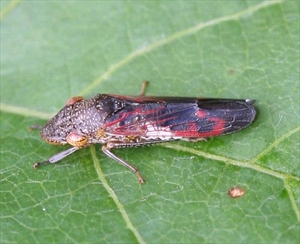- Widespread distribution. North, South, Central America, Oceania. On citrus, almond, avocado, grape, peach, olive, and more. An important pest.
- The leafhopper spreads a bacterium (Xylella).
- Eggs laid in leaves covered in white powder. Adults and nymphs feed on sap, excreted as 'leafhopper rain'. Adults, cigar-shaped, 12-14 mm, dark above and light below. Spread by flight, and in nursery trade.
- Biosecurity: a major concern because of its restricted distribution, and it spread important diseases.
- Natural enemies: introduction of wasp parasitoids is the primary control method.
- Cultural control: none recommended.
- Chemical control: white and horticultural oils and soaps are used; imidacloprid applied either as a foliar spray or to the soil. Soil application lasts longer and does less harm to wasp parasitoids.






